Microorganisms: Friend and Foe
NCERT-Class-8-Science-Chapter-2
Notes
|
Topics to be learn :
|
Introduction :
Microorganisms, or microbes, are extremely small organisms that cannot be seen with the naked eye.
During rainy seasons, greyish white patches on moist bread can be observed through a magnifying glass, revealing tiny black rounded structures called fungi.
Some microorganisms, like fungus, can be seen with a magnifying glass, others require a microscope to see.
Microorganisms :
The microorganisms may be unicellular or multicellular.
Microorganisms are classified into four major groups. These groups are bacteria, fungi, protozoa and some algae.
(i) Bacteria :
- These are the simplest unicellular organisms having rigid cell wall like plant cells,
- Examples : Lactobacillus, E.coli, etc.

(ii) Fungi :
- It is a large group of organisms which do not have chlorophyll and hence, do not photosynthesise. Thus, they are heterotrophs,
- Examples : Yeast, Penicillium, Aspergillus, Rhizopus (bread mould).
- Fungi may be unicellular or multicellular.

(iii) Protozoa :
- It is a group of single-celled microorganisms that have animal like characteristics.
- They can move from place to place,
- Diseases like dysentery and malaria are caused by protozoans.
- Examples : Amoeba and Paramecium.
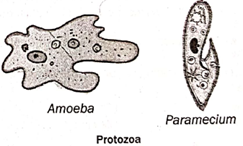
(iv) Algae :
- It is a large group of simple, plant-like organisms.
- They have no true roots, stems or leaves.
- They can be unicellular or multicellular.
- Algae are photoautotrophic organisms that carry out photosynthesis,
- Examples : Chlamydomonas, Spirogyra, etc.
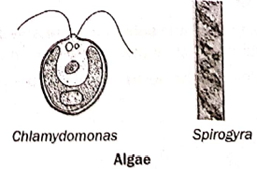
Viruses :
- These are also microscopic organisms but are different from other microorganisms. They reproduce only inside the cells of the host organisms.
- These host organisms can be a bacterium, plant or animal.
- Common ailments like cold, influenza (flu) and most coughs are caused by viruses. Serious diseases like polio and chickenpox are also caused by viruses.
Where do Microorganisms Live?
- Microorganisms spread over the entire biosphere, e.g. in soil, water, air, inside the bodies of animals, including humans, etc.
- They are characterised by a very high degree of adaptability, as they can survive in all types of environment, ranging from ice cold climates to hot springs and deserts to marshy lands.
- Some microorganisms grow on other organisms, while others exist freely. Microorganisms like Amoeba can live alone, while bacteria and fungi may live in colonies.
Know This :
|
Microorganisms and Us
Microorganisms have a dual role in our existence. They not only provide several advantages, but also cause a large variety of disorders.
Friendly Microorganisms : Microbes are used for various purposes. Some common beneficial activities of microbes are discussed below
Making of Curd and Bread :
Microbes in Household Products : Some of the household products obtained from microbial activities are as follows
- Curd : It contains several microorganisms. Of these, the bacterium, Lactobacillus promotes the formation of curd. It multiplies in milk and converts milk into curd. The curd is added to rava idlis and bhaturas to make them soft and spongy.
- Baking industry : The dough for making bread, cakes and pastries is prepared by adding yeast to flour. Yeast reproduces rapidly and produces carbon dioxide (CO2) during respiration. Bubbles of this gas fill the dough and increase its volume. It adds sponginess to cake and bread.
- Bacteria are also involved in the making of cheese, pickles and the other food items. Bacteria along with yeast are helpful for fermentation of rice idlis and dosa batter.
Commercial Use of Microorganisms :
- Microbes are used for the large scale production of alcohols, wine and acetic acid (vinegar).
- Yeast is used for commercial production of alcohol and wine. For this purpose yeast is grown on natural sugars present in grains like barley, wheat, rice, crushed fruit juices, etc.
- The process of conversion of sugar into alcohol is called fermentation.
- Louis Pasteur discovered fermentation in 1857.
Medicinal Use of Microorganisms :
Doctors prescribe antibiotics and vaccines for illness treatment. The source of these antibiotic medicines and vaccines are microorganisms.
The details of antibiotic medicines and vaccines are given below
(i) Antibiotics :
The medicines, which are used to kill or stop the growth of the disease causing microorganisms are known as antibiotics.
- These antibiotics in the form of tablets, capsules or injections are products of microorganisms (mainly bacteria and fungi), e.g. penicillin, streptomycin, tetracycline, erythromycin.
- The antibiotics are manufactured by growing specific microorganisms and are used to cure a variety of diseases.
- Antibiotics are even mixed with the feed of livestock and poultry to check microbial infection in animals.
- They are also used to control many plant diseases.
- Antibiotics are not effective against cold and flu as these are caused by viruses.
Precautions to be taken for using antibiotics :
- It should be taken only on the advice of a qualified doctor in proper dose. In wrong doses (or taken when not needed), it becomes less effective when taken in future.
- Person must complete the course as prescribed by the doctor.
- It should not be taken unnecessarily as it may kill useful bacteria in the body.
Know This :
History of Antibiotic: PenicillinThe first antibiotic penicillin which was discovered by Alexander Fleming in 1929. He was working on a culture of disease causing bacteria. During the experiment he observed that the presence of a mould in one of his culture plate prevented the growth of bacteria. In fact it also killed many of these bacteria. From this mould penicillin was prepared. |
(ii) Vaccine :
- Vaccine It is a biological preparation that provides immunity (or protection) against a particular disease.
- A vaccine consists of dead or weakened microbes which when introduced in a healthy body, produces suitable antibodies to fight and kill the invading bacteria/microbes.
- These antibodies remain in the body to protect from disease causing microbes, thus developing immunity.
- The diseases which can be prevented by vaccination are polio, cholera, tetanus, rabies, TB, smallpox, measles and hepatitis.
| Know This : |
· Edward Jenner discovered the smallpox vaccine in 1798.
· A worldwide campaign against smallpox has finally led to its eradication from most parts of the world.
· Pulse Polio Immunisation Programme was launched in India in 1995 for eradication of polio. Children in the age group of 0 (zero) month to 5 years are administered polio drops (actually vaccine) every year.
Increasing Soil Fertility :
- Some bacteria and cyanobacteria (blue-green algae) are able to fix nitrogen from the atmosphere to enrich soil with nitrogen and increase its fertility.
- These microbes are commonly called biological nitrogen fixers, e.g. Rhizobium.
Cleaning the Environment :
- Microorganisms decompose dead organic waste of plants and animals, converting them into simple substances. These substances are again used by other plants and animals.
- The microorganisms are used to degrade the waste and smelly substances from our biosphere and thereby clean the environment.
Harmful Microorganisms :
The microorganisms are harmful in many ways. Some of these cause diseases in human beings, plants and animals.
Such disease causing microorganisms like bacteria, fungi, virus and protozoans are called pathogens. They enter the body by various means, where they multiply and cause harm to the body.
Some of their activities are described below.
Disease Causing Microorganisms in Humans :
Certain microbial diseases are spread from infected person to a healthy individual through air, water, food or physical contact. Such diseases are called communicable diseases, e.g. cholera, common cold, chickenpox and tuberculosis.
Transmission of Communicable Diseases :
There are various ways through which communicable diseases can be transmitted. These are as follows
- Common cold or flu: Viral droplets spread through sneezes, coughs, or spits, causing infections like tuberculosis.
Direct contact with infected person: Chickenpox, ringworm.
Food or water: Cholera, typhoid. - Vectors or carriers : Through vectors or carriers like some insects and animals. The organisms that transmit pathogens from an infected individual to a healthy one are known as carriers.
- For example, Housefly is one such carrier. The flies sit on the garbage and animal excreta, accumulating pathogens on their bodies. When these flies land on exposed food, they can transfer these pathogens.
- Female Anopheles mosquito which carries the parasite of malaria (Plasmodium).
- Female Aedes mosquito acts as a carrier of dengue virus.
Prevention of Communicable Diseases :
Some methods of preventing the occurrence and spread of communicable diseases are as follows
- Cover mouth and nose with a handkerchief while sneezing.
- Keep your food covered and avoid consuming uncovered food items.
- Drink clean and safe water.
- Use mosquito nets and mosquito repellent creams to protect yourself from mosquito bites.
- Take vaccination at proper time.
- Avoid breeding of mosquitoes by not allowing water to collect anywhere, i.e. in coolers, tyres, etc. and by keeping surroundings clean and dry.
Some Common Human Diseases caused by Microorganisms :
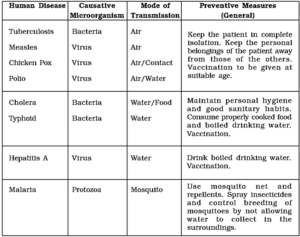
Disease causing Microorganisms in Animals :
Several microorganisms not only cause diseases in humans, but also in other animals, e.g. Anthrax is a dangerous human and cattle disease caused by a bacterium.
Robert Köch (1876) discovered the bacterium (Bacillus anthracis) which causes anthrax disease.
Common animal diseases caused by microorganisms :
| Animal diseases | Microorganisms | Animal affected |
| Anthrax | Bacteria (Bacillus anthracis) | Cattle and human |
| Foot and mouth disease | Virus | Cattle |
Disease causing Microorganisms in Plants :
Several microorganisms cause diseases in plants like wheat, rice, potato, sugarcane, orange, apple, etc. These diseases reduce the yield of crops. They can be controlled by the use of certain chemicals which kill the microbes.
Common plant diseases caused by microorganisms :
| Plant Diseases | Micro-organism | Mode of Transmission |
| Citrus canker | Bacteria | Air |
| Rust of wheat | Fungi | Air, seeds |
| Yellow vein mosaic of bhindi (Okra) | Virus | Insect |
Food Poisoning :
- Microorganisms on food can produce toxic substances, leading to spoilage.
- This chemical change can cause foul smells, bad tastes, and changes in color. Consumption of spoilt food can lead to food poisoning, causing symptoms like vomiting, diarrhea, headaches, and fever, which can cause serious illness and even death.
- Therefore, preserving food is crucial to prevent spoilage.
Food Preservation
The process by which spoilage of food is prevented using suitable chemical or physical methods is called food preservation.
Some of these methods are given below
(i) Chemical method :
- The chemicals used to check the growth of microorganisms are called preservatives.
- Salts, edible oils and acid preservatives are added to pickles to prevent the attack of microbes.
- Sodium benzoate and sodium metabisulphite are common preservatives used to check the growth of microbes.
- They are added in jams and squashes to check their spoilage.
(ii) Preservation by common salt :
- It has been used to preserve meat and fish for ages.
- Salting is also used to preserve amla, raw mangoes, tamarind, etc.
(iii) Preservation by sugar :
- Jams, jellies and squashes are preserved by sugar.
- It reduces the moisture content which inhibits the growth of bacteria which spoil food.
(iv) Preservation by oil and vinegar :
- Use of oil and vinegar prevents spoilage of pickles because bacteria cannot live in such an environment.
- Vegetables, fruits, fish and meat are preserved by this method.
(v) Heat and cold treatments :
Boiling kills many microorganisms. Similarly, we keep our food in the refrigerator as low temperature inhibits the growth of microbes.
(vi) Pasteurisation :
- It is used for the preservation of milk.
- It involves the process of heating milk to about 70℃ for 15 to 30 seconds (killing most of bacteria) and then cooling it quickly at a very low temperature.
- This milk is then stored in cold temperature.
- Pasteurised milk can be consumed without boiling as it is free from harmful microbes.
- The milk that comes in packets does not get spoiled as it is pasteurised.
- The process of pasteurisation was discovered by Louis Pasteur.
(vii) Storage and packing :
- These days dry fruits and even vegetables are sold in sealed air tight packets. This helps to preserve food by keeping germs and microbes out.
- Airtight packets also prevent food from moisture and contamination.
| Know This :
Irradiation is a modern method of food preservation. The food is exposed to high energy gamma rays or X-rays. These powerful radiations completely destroy the harmful microorganisms. The food can be preserved for years without refrigeration. |
Nitrogen Fixation :
- Nitrogen gas, present in the atmosphere, cannot be directly utilized by plants.
- It is taken up by plants from the soil only when it is converted to nitrogenous compounds.
- The process of conversion of atmospheric nitrogen into nitrogenous compounds is called nitrogen fixation.
Nitrogen can be fixed by
(i) Lightning is a natural process that converts nitrogen into a usable form.
(ii) Rhizobium bacteria is involved in the fixation of nitrogen in leguminous plants. These bacteria live in the root nodules of leguminous plants such as beans and peas, with which it has a symbiotic relationship.
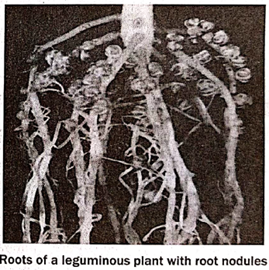
(iii) Some of the blue-green algae have capacity to fix nitrogen, e.g. Anabaena, Nostoc, etc.
The atmospheric nitrogen although continuously used up by plants and animals, remains constant. This happens through a cycle of processes grouped together called nitrogen cycle.
Nitrogen cycle :
The nitrogen cycle is a continuous process where nitrogen, a crucial component of all living organisms, is circulated through both living and non-living things, with our atmosphere containing 78% nitrogen gas.
- Nitrogen is one of the essential constituents of all living organisms. It is a part of proteins, chlorophyll, nucleic acids and vitamins.
The main steps in this cycle are as follows :
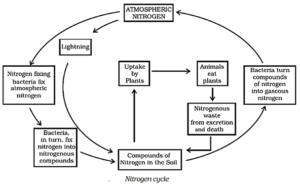
- The atmospheric nitrogen is fixed through various means and is converted into usable compounds.
- These compounds are utilised by plants from the soil through their root system. This nitrogen is used for synthesis of plant proteins and other compounds.
- Animals taking these plants as food, get these proteins and other nitrogen compounds.
- When these plants and animals die, certain bacteria and fungi convert these complex nitrogenous compounds present in their bodies into simple nitrogenous compounds. These simple nitrogenous compounds are again absorbed by the plants for their growth.
- Certain other bacteria convert some of these compounds into nitrogen gas which goes back into the atmosphere. As a result, the percentage of nitrogen in atmosphere remains nearly constant.
Chapter Glossary :.
|
Click on below links to get PDF from store
PDF : Class 8-Science-Chapter-2-Microorganisms: Friend and Foe-Notes
PDF : Class 8-Science-Chapter-2-Microorganisms: Friend and Foe-Solution
Main Page : NCERT-Class-8-Science – All chapters notes, solutions, videos, test, pdf.
Previous Chapter : Chapter-1- Crop production and management – Online Notes
Next Chapter : Chapter-3- Coal and Petroleum – Online Notes

We reply to valid query.